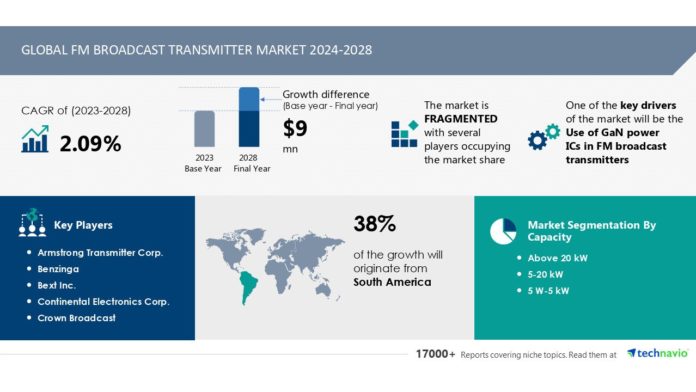The Global FM Broadcast Transmitter Market size is estimated to grow by USD 9 million from 2024-2028, according to Technavio. The market is estimated to grow at a CAGR of 2.09% during the forecast period. Use of gan power ICS in FM broadcast transmitters is driving market growth, with a trend towards growing demand for solid-state transmitters, However, high growth of online radio services poses a challenge – Key market players include Armstrong Transmitter Corp., Benzinga, Bext Inc., Continental Electronics Corp., Crown Broadcast, DB Elettronica Telecomunicazioni Spa, Eddystone Broadcast Ltd., Electrolink Srl, EuroCaster, Feeding Trends, GSMArena, HOPE Microelectronics Co. Ltd., Nautel Ltd., OMB Sistemas Electronicos SA, PCS Elektronik d.o.o., Plisch GmbH, Rohde and Schwarz GmbH and Co. KG, RVR Elettronica Srl, TEKO Broadcast Srl, and Thomson Broadcast.
Modern FM broadcast transmitters are shifting towards solid-state technology, with solid-state transmitters becoming a cost-effective and efficient solution for transmitter designs up to several hundred watts. These transmitters utilize transistors or integrated circuits, which can operate at various frequencies and power levels. However, high-power transmitters require multiple transistors in parallel due to the limited output of individual devices. In contrast, the cost of valve transmitter devices and their combining networks can be substantial. With the increasing availability and decreasing prices of solid-state transmitters, they are poised to replace valve amplifiers in the FM broadcast market, driving market growth during the forecast period.
The FM Transmitter Market is thriving with the increasing demand for personal audio devices and in-car entertainment. FM transmitters, wireless communication systems that convert audio from various sources into FM radio signals, are gaining popularity as an alternative to standard FM radio. New models offer simplicity and high-quality sound through features like near radio technology, USB ports, and Bluetooth connectivity. Transmitter networks enable new stations to broadcast qualitative information to wider audiences. HD Radio technology enhances audio quality and reduces interference. The automotive sector is a significant market for FM transmitters, providing emergency communication and entertainment solutions. Smart technologies like app control and remote monitoring are also trending. The Telecommunication and Broadcasting industries continue to innovate with cutting-edge solutions, including signal processing and wireless audio transmission. FM transmitters are essential components of electromagnetic communication systems, including radio broadcasting, television, radar, and antennas. The market’s growth is driven by the need for reliable and high-performance wireless communication systems in various industries.
The rise of digital audio platforms, such as streaming services and apps, has significantly changed the way people consume audio content. With over half of the US population owning smartphones and the ability to easily access Internet radio through these devices, traditional FM broadcasting faces challenges. Digital radio offers superior sound quality and a more personalized listening experience through data analytics. New cars are equipped with connectivity options for smartphones, enabling the playback of stored audio files or live digital streams. These advantages may eventually impact the demand for FM broadcast transmitters, potentially hindering market growth during the forecast period.
The FM broadcast transmitter market faces challenges from various sectors. Personal audio devices and in-car entertainment have reduced the need for traditional radio broadcasting. In the automotive sector, USB ports and Bluetooth have become popular for wireless audio transmission. Signal processing and wireless audio transmission require cutting-edge solutions and smart technologies for interference reduction and HD Radio technology. Emergency communication, community radio, and event broadcasting demand robust and reliable transmitters. Remote monitoring, app control, and USB connections with Bluetooth connectivity are essential features. Challenges include interference, audio quality, bandwidth restriction, and lack of awareness in developing regions. The telecommunication and broadcasting industries, mobile electronics, military sector, aerospace market, and television industry are significant markets for broadcast transmitters. Technological developments in modulation range and digitization continue to shape the market.
Above 20 kW FM broadcast transmitters, also known as high-power transmitters, are a crucial component in radio broadcasting. These transmitters are of high quality, cost-efficient, reliable, and have a long life. Vendors like DB Elettronica Telecomunicazioni offer high-power tube transmitters, which cover a distance of up to 200 km and have a compact design for increased efficiency. Key features of these transmitters include a digital stereo encoder, built-in multiband audio processor, dual system control, switchable settings, RF power control, VSWR and overheat protection. The growth of the 20kW segment will be driven by these features, making it a significant market focus during the forecast period. Despite the increasing popularity of on-demand music streaming services, FM radio remains widely used, and high-power transmitters continue to play a vital role in broadcasting radio signals to listeners either directly or via repeater stations.
The FM broadcast transmitter market encompasses innovative audio devices that facilitate radio broadcasting through standard FM radio waves. These transmitters are integral to wireless communication systems, providing in-car entertainment and personal audio experiences. Transmitters enable new stations to reach listeners, delivering high-quality audio with simplicity and ease. FM transmitters are essential components of wireless audio transmission, offering a cost-effective solution for broadcasting qualitative information to a wide audience. Near radio technology and Bluetooth connectivity enhance user experience, allowing seamless integration with various devices, including headphone jacks, USB ports, and other personal audio devices. Signal processing is a crucial aspect of FM transmitters, ensuring clear and consistent audio transmission. Transmitter networks play a vital role in expanding radio broadcasting reach and ensuring reliable, uninterrupted transmission. FM transmitters cater to diverse industries, including the automotive sector, offering cutting-edge solutions for radio broadcasting and wireless communication.
The FM Transmitter Market refers to the business sector focused on producing and supplying FM transmitters, which are devices used for wireless audio transmission. FM transmitters are essential components of radio broadcasting, in-car entertainment systems, and personal audio devices. They convert electrical signals into electromagnetic waves that can be received by standard FM radios and near radio devices. FM transmitters are available in various forms, including transmitter networks, USB ports, Bluetooth, and app control. These devices prioritize high-quality audio transmission, simplicity, and interference reduction. New stations and community radio broadcasters often rely on FM transmitters for qualitative information dissemination. The FM Transmitter Market caters to various industries, including the automotive sector, telecommunication industry, and broadcasting industry. Technological developments, such as HD Radio technology, smart technologies, and emergency communication systems, are driving market growth. However, bandwidth restriction and a lack of awareness in developing regions may pose challenges. FM transmitters are used in various applications, including television, radar, antenna systems, mobile electronics, beacons, walkie talkies, smartphones, and military and aerospace markets. The market is expected to witness significant growth due to digitization, the entertainment industry, and the modulation range of FM transmitters.







